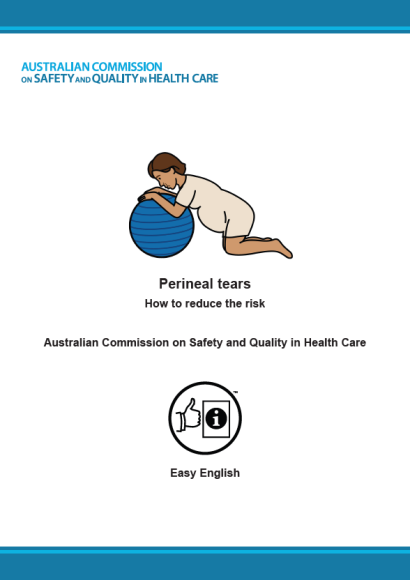Information for women – Third and Fourth Degree Perineal Tears Clinical Care Standard
This standard supports a woman-centred approach, so women are informed about their risk of a third or fourth degree perineal tear and supported to make decisions and provide informed consent for the care they receive during pregnancy, labour and birth.
Third and fourth degree perineal tears: A video for women
Webcast video recording – Launch
The Commission hosted a webcast to launch the standard on 21 April 2021.
The launch and panel discussion hosted by Professor Anne Duggan, Acting Chief Medical Officer, provides an overview of the new standard, and discusses some of the evidence driving the need for change.
Expert panellists include obstetrician Associate Professor Emmanuel Karantanis, midwifery expert Professor Hannah Dahlen, physiotherapist Natalie McConochie, and Janelle Gullan, a woman who experienced a third-degree perineal tear.
What is a perineal tear?
A perineal tear is an injury to the perineum, which is the area between the vagina and anus.
During labour, the skin and muscles around your vagina stretch to allow your baby to be born. Sometimes the area between your vagina and anus (the perineum) gets torn. This is known as a perineal tear.
Perineal tears are common and most heal well either naturally or with stitches. Some perineal tears are more serious and require surgical repair.
Tears are usually graded by ‘degrees’ from one to four according to how much of the area is affected.
| Type of tear | Where it occurs | Treatment |
|---|---|---|
| First degree | Skin of the perineum | May need stitches |
| Second degree | Muscles of the perineum | Usually need stitches |
| Third degree | Muscles controlling the anus | Surgical repair |
| Fourth degree | Lining of the anus | Surgical repair |
The diagram below shows the areas affected by a perineal tear

How many women are affected by a third or fourth degree perineal tear?
Third or fourth degree perineal tears affect:
- Around 3 out of 100 women giving birth vaginally
- Around 5 out of 100 women giving birth vaginally for the first time.
Most women who sustain a third or fourth degree perineal tear recover well with appropriate treatment and support, although some will need specialised care to optimise their recovery.
While not all third and fourth degree perineal tears can be prevented, it is possible to reduce the risk of their occurrence.
What does this standard mean for you?
This national standard describes best practice care for the prevention, recognition and management of third and fourth perineal tears. Find out what the Third and Fourth Degree Perineal Tears Clinical Care Standard says and what it means for you in the statements below. Reading these statements will inform your discussion with your healthcare professional.
Consumer guide to the clinical care standard
Information resources for women
A number of resources have been developed to support the Third and Fourth Degree Perineal Tears Clinical Care Standard.
-
2021Fact sheet or brochure
This document describes each of the seven quality statements in this clinical care standard and what they mean for women.
-
2021Fact sheet or brochure
This information sheet for women is about perineal tearing during childbirth. It explains what can be done to reduce the risk of a third or fourth degree perineal tear.
-
2021Fact sheet or brochure
If you have a third or fourth degree perineal tear during childbirth, this information sheet will help you understand the treatment and follow-up care you should receive to support your recovery.
Easy English resources
The resources have been translated into a writing style called ‘Easy English’. It is a writing style that is concise and easy to understand and uses simple language and carefully selected images to support key messages. These useful resources will assist in explaining perineal tears to women.
-
2022Fact sheet or brochure
This information sheet for pregnant women is about perineal tears. It explains how to reduce the risk of a third or fourth degree perineal tear during childbirth, written in Easy English with pictures.
-
2022Fact sheet or brochure
If you have a third or fourth degree perineal tear during childbirth, this information sheet is about how to get better – written in Easy English with pictures.





